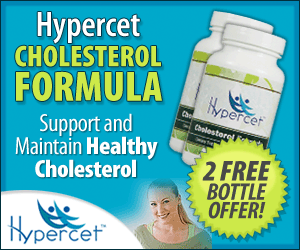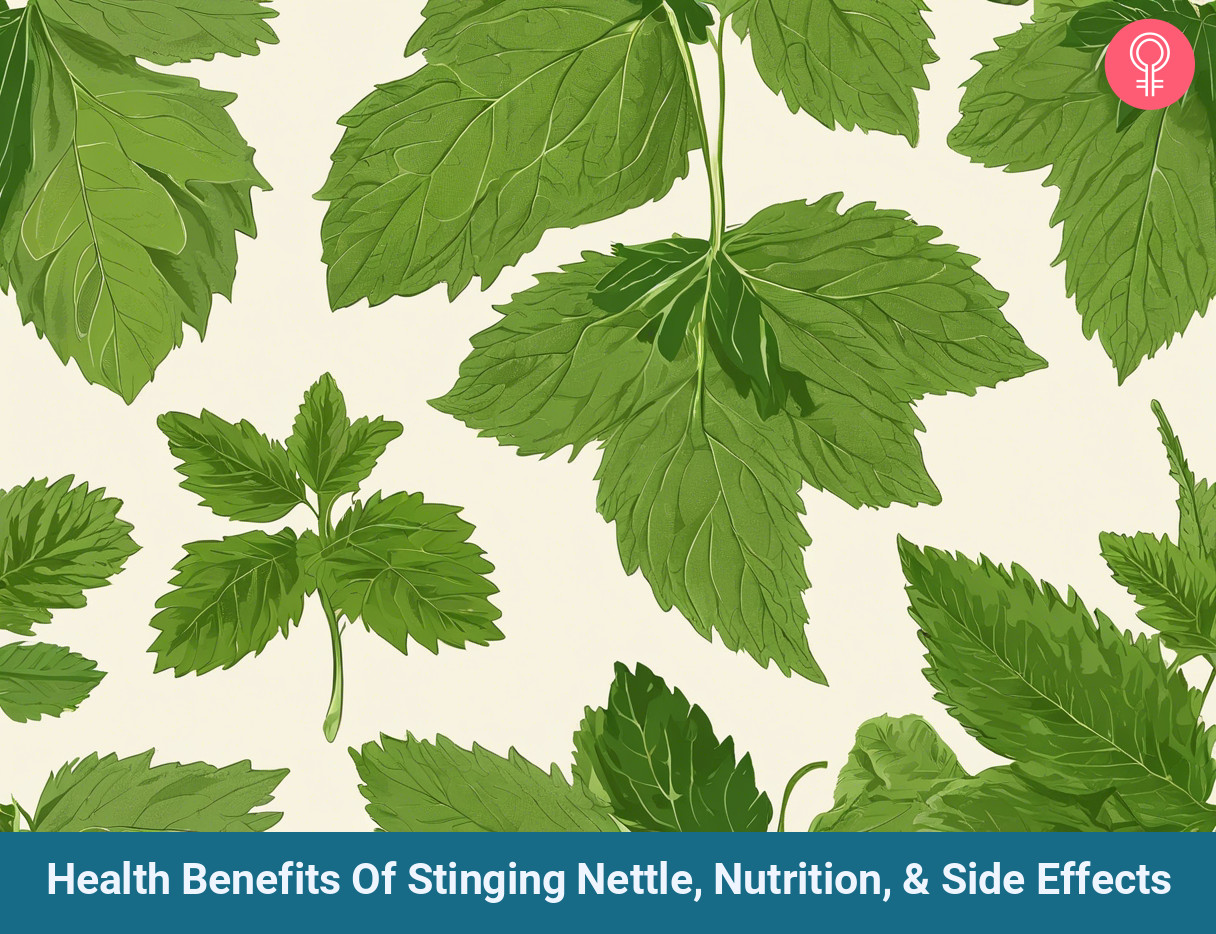Painful nettle (Urtica diocia) is a flowering plant that was made use of by ancient Egyptians to deal with reduced back pain and joint inflammation ( 1 ). This typical organic medication is applauded for its therapeutic value. The advantages of painful nettle can be credited to its recovery properties.
The consumption of stinging nettle in the form of an organic drink can help treat asthma and allergic reactions, control blood sugar degrees, improve urinary system wellness, and advertise hair growth.
In this post, we have reviewed the benefits, nutritional profile, and some possible negative effects of painful nettle and exactly how to eat it. Maintain analysis!
Know Your Ingredient: Stinging Nettle
What Is It?
This plant has pointed fallen leaves and white to yellow-colored blossoms, and every little thing from the origins to the upper components are used.
What Are Its Benefits?
Stinging nettle helps to resolve prostate issues, manage diabetes and even relieve allergies and body pain.
Who Can Consume It?
Anyone looking to resolve their urinary and prostate gland issues can drink stinging nettle tea.
How Often?
You can drink 3 cups a day.
Caution
Avoid using if you are expecting or nursing because there is little data on its safety.
In This Article
What Is Stinging Nettle?
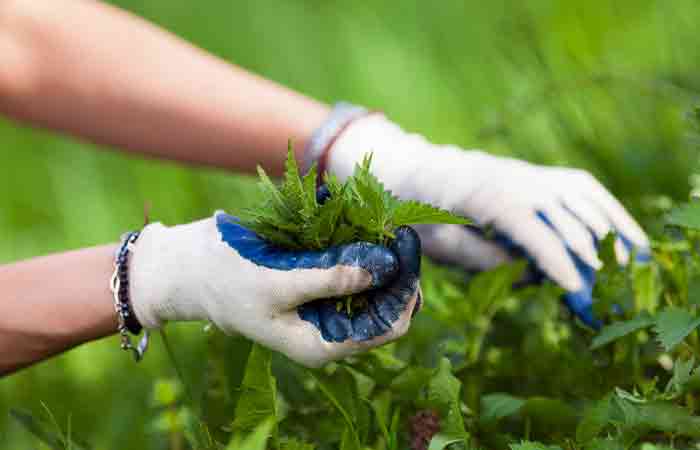
The stinging nettle ( Urtica dioica ) has been a staple herbal medicine since ancient times ( 2 ). It has an exotic biochemical account. It expands in mild to temperate environments across the globe-- especially in position with a lot of wetness. You can find certain species of nettles commonly in woodlands, by the rivers or streams, and on roadsides.
Its scientific name Urtica dioica comes from the Latin word uro, which indicates "to shed," since its leaves can trigger a momentary burning feeling upon contact. These plants (or weeds) are belonging to Mexico, Italy, Nepal, India, China, Russia, Netherlands, North America, and parts of Africa. Specific types of nettle, particularly the painful nettle, have hairs on their leaves and airborne components. A few of these sting too! Therefore, the name ( 1 ).
The leaves are densely covered with stinging hairs, which release potentially pain‐inducing toxins ( 1 ).
When human skin is available in call with a nettle leaf or stem, it rapidly develops red patches that impulse and burn, ruining your healthy skin disease. The hairs or trichomes of the plant are naturally developed to safeguard the plant from bugs.
However, consuming this wonderful herb after processing is secure. The complying with section is everything about the advantages of stinging nettle leaves. Begin scrolling!
What Are The Health Benefits Of Stinging Nettle?
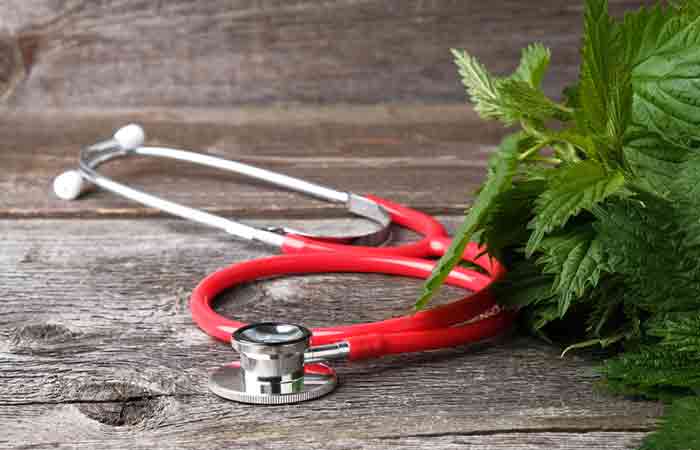
1. May Boost Hair Growth And Strength
Traditional medicine used Urtica species to stimulate hair growth. A study investigated this property of stinging nettle ( Urtica dioica ) with a combination of herbal extracts . This herbal preparation increased the proliferation of human dermal papilla cells ( 3 ).
The β-sitosterol in stinging nettle triggers the development of new blood vessels (angiogenesis). It encourages the synthesis of vascular endothelial growth element (VEGF) and supports new hair development ( 3 ).
The fallen leaves and origins of painful nettles manage the task of the sex hormonal agents and their substrates. They aid manage hair loss (alopecia) in males and females with hormonal discrepancies ( 4 ).
Related: 13 Science-Backed Tips To Stimulate Hair Growth Naturally
2. May Treat Hay Fever, Asthma, And Allergies
Hay fever or allergic rhinitis is brought on by plant pollen, allergen, mold, fungi spores, cockroaches, and plumes. Various other causes include food level of sensitivity, metabolic illness, and specific medications. Its symptoms include sneezing, nasal blockage, itching, lacrimation (consistent tearing), frustration, dry mouth, sleepiness, fatigue, and cardiac arrhythmia ( 5 ).
This is where alternative medicine may come to the rescue ( 5 ), ( 6 ). Stinging nettle ( Urtica dioica ) contains nicotinamide, synephrine, and osthole, with potent anti-inflammatory and anti-allergenic properties.
These phytochemicals exhibit an antagonist activity against the pro-inflammatory histamine receptors, blocking the production and release of histamine ( 5 ). They also interfere with the activity of pro-inflammatory cells, chemical messengers, and the controlling genes ( 5 ).
According to a study , bronchial asthma is one of one of the most typical respiratory system health problems in kids. The study likewise specified that around 80% of asthma-related fatalities happen in developing nations. Better, it highlighted that bronchial asthma occurrence gets on the boost especially in the Eastern Mediterranean Region of the world.
Health professionals ought to check out using alternative medicine to deal with severe and chronic problems like asthma, respiratory tract allergies, and so on as an option to typical drugs ( 6 ).
Related: 9 Effective Home Remedies For Asthma Attack
3. May Help Manage Prostate Issues
Overgrowth of the prostate gland (benign prostatic hyperplasia i X The very first step in the progression of cancer where the organ or tissue expands due to a rise in cell development.) enhances the pressure on the urethra. This disables the urinary system and triggers numerous persistent disruptions with aging ( 7 ).
In rat studies, stinging nettle came along in prostate wellness. Nettle root removes hinder aromatase, an enzyme that converts testosterone right into estrogen. Estrogen is very closely linked to prostate problems ( 7 ).
Various other research studies show the antiproliferative residential or commercial properties of nettle root in human cancer cells. A 20% alcoholic remove of painful nettle origin lowered the growth of cancerous prostatic epithelial cells over a seven-day program ( 8 ).
4. May Reduce Inflammation
Stinging nettle extract contains an anti-inflammatory substance that can suppress several cytokines in inflammatory joint diseases ( 9 ).
According to another study, applying stinging nettle leaf appears to provide osteoarthritic pain relief ( 10 ). Stinging nettle reduced levels of multiple inflammatory hormones by interfering with their production ( 11 ).
However, more research and human studies are required to recommend nettle as an anti-inflammatory treatment.
Related: Skin Inflammation: Causes, Symptoms, Diagnosis, And Treatment
5. May Lower Blood Pressure
Stinging nettle was traditionally used to treat high blood pressure ( 12 ). Stinging nettle extract was found to possess antihypertensive i X A compound that reduces high blood pressure degrees by removing liquid and salt from the body or broadening the capillary. effects.
It might help reduced blood pressure by enabling blood vessels to loosen up and reducing the pressure of the heart's tightenings . More human studies are needed to confirm these effects.
6. May Aid Blood Sugar Control
Nettle has actually shown some appealing effects on blood sugar levels. Traditional medicine utilizes nettle entrusts to treat diabetic issues mellitus due to their anti-hyperglycemic i X A substance that may lower blood glucose levels and inhibit the abnormal sugar accumulation in the blood. properties ( 13 ).
Nonetheless, more research study on human beings is needed to establish the safety and effectiveness of nettle leaves in controlling blood sugar level levels.
7. May Monitor Heart And Liver Health
In a 2018 rat research, the administration of 150 mg/kg/day stinging nettle essence for a month boosted the blood lipid profile. The nettle remove worked far much better than its industrial synthetic drug equivalent ( 14 ).
Nettle extract boosts the antioxidant machinery in the body, thereby preventing (and ending) lipid peroxidation. A balanced lipid profile and healthy liver reduce the risk of hypercholesterolemia i X A problem that causes elevated blood cholesterol degrees. It restricts blood circulation which raises the danger of cardio disorders. -caused conditions ( 15 ).
Hypercholesterolemia is linked to atherosclerosis i X The gradual solidifying and constraint of the arteries because of cholesterol and fat plaques obstructing them. and other inflammatory diseases. Nettle fallen leave helps avoid atherosclerosis and high blood pressure, as per rat research studies. It is, thus, a potent hepato- and cardioprotective nutritional additive ( 16 ).
8. May Help Treat Menstrual Health, PCOS, And Fertility Concerns
Around 10%-15% of women of reproductive age experience oligomenorrhea and 3%-4% of them have amenorrhea.
Oligomenorrhea and amenorrhea are adjustments in normal menstrual cycles that cause lengthy menstrual cycles and the absence of menstruation, specifically. While hormonal agent substitute therapy is one of the most typical solution, natural medicine is confirming to be efficient in such situations ( 17 ).
Herbal essences of nettle, pepper mint, onion, and nigella showed a favorable result on polycystic ovary disorder (PCOS). They could regulate menstrual blood loss, relieve menstruation irregularities, equilibrium hyperandrogenism i X The state of and results of high male sex hormonal agent degrees in women, particularly testosterone, androsterone, and androstenedione., and promote fertility ( 17 ).
These natural herbs have phytochemicals, including flavonoids, phenols, phytosterols, and terpenoids, that can simulate the all-natural hormone feature and limit blood loss. That is why nettle plant components can boost follicle growth, minimize coagulation aspects, unwind uterine muscles, and assist in uterine recovery ( 17 ), ( 18 ).
TriviaNettle is just one of the plants pointed out in the 10th-century pagan medical Anglo-Saxon book, 9 Natural herbs Appeal. It was believed to be a galactagogue (encouraged lactation).
9. Can Accelerate Wound Healing
Injury healing could obtain prolonged in the presence of free radicals and several physiological stresses. The delay might impact one or all actions of wound contraction, recuperation of epidermal cells (reepithelialization), and remediation of blood supply (neovascularization) ( 18 ).
Using plant medication for healing injuries is an old remedy. Numerous flowering plants like stinging nettle have actually been lauded for their vulnerary and antioxidant residential properties.
The nettle leaf has an antihemorrhagic i X Additionally known as hemostatic, a medicine or material that might stop or minimize blood loss. impact as a result of its flavonoids, minerals, vitamins, and fat content ( 18 ).
Utilizing stinging nettle remove on injuries would certainly lower the bleeding time and advertise blood clotting. It likewise gets rid of virus, traps the pro-inflammatory complimentary radicals, and minimizes the ordinary recovery time in rat models ( 18 ).
10. May Help Manage Eczema
Nettle has been traditionally utilized to manage skin disease like eczema. Its anti-inflammatory homes might help reduce the itching, inflammation, and swelling related to the condition ( 19 ), ( 20 ), ( 21 ).
Painful nettle is likewise rich in vitamins, minerals, and antioxidants that may assist nourish the skin and boost one's total wellness ( 22 ).
However, more studies are warranted to further understand the role of stinging nettle in managing eczema.
Additionally, do keep in mind that specific actions to nettle might vary. Therefore, get in touch with a medical care professional and do a spot test prior to incorporating nettle into your routine. Stop use if you experience any type of negative effects.
In other words, the fallen leave, root, and various other components of the stinging nettle have effective antioxidant, vulnerary, antihemorrhagic, anti-inflammatory, anti-atherosclerotic, anti-hypercholesterolemic, cardioprotective, hepatoprotective i X The ability of a material to protect the liver from damages and aid it heal from injury caused by toxins., anti-allergic, and anti-diuretic properties.
TriviaCosmetic makers make use of nettle largely for shampoos and conditioners. Food shades and material dyes can be made from its leaves.
Shouldn’t there be something in the nettle plant parts that impart(s) these properties?
Absolutely! Learn more about them in the following section.
Nutritional Profile Of Stinging Nettles

The painful nettle plant includes a tons of phytochemicals. The fresh fallen leaves include β-carotene, violaxanthin, xanthophylls, zeaxanthin, luteoxanthin, and lutein epoxide that present those wonderful advantages to this natural herb.
Nettle also includes phenolic acids, including carbonic, caffeic, caffeoyl malic, chlorogenic, formic, silicic, citric, fumaric, glyceric, malic, ellagic, oxalic, phosphoric, and succinic acids ( 23 ).
Quercetin, myricetin, isorhamnetin, kaempferol, and so on are the flavonoids. Acetylcholine, betaine, choline, lecithin, histamine, scololeptin, rutin, rosinidin, and naringin are a few other phytochemicals present in the nettle leaf, root, and stalk ( 23 ).
This medicinal natural herb ratings well in nutrition as well. The leaves have copious amounts of potassium, calcium, folate, vitamins A and K, basic carbohydrates, protein, and necessary forerunners.
| Nutritional value Of Nettle Leaves | ||
|---|---|---|
| Nutrient | Unit | Serving size (1 cup 89 g) |
| Water | g | 78.03 |
| Energy | kcal | 37 |
| Energy | kJ | 156 |
| Protein | g | 2.41 |
| Total lipid (fat) | g | 0.10 |
| Ash | g | 1.81 |
| Carbohydrate, by difference | g | 6.67 |
| Fiber, total dietary | g | 6.1 |
| Sugars, total | g | 0.22 |
| Minerals | ||
| Calcium, Ca | mg | 428 |
| Iron, Fe | mg | 1.46 |
| Magnesium, Mg | mg | 51 |
| Phosphorus, P | mg | 63 |
| Potassium, K | mg | 297 |
| Sodium, Na | mg | 4 |
| Zinc, Zn | mg | 0.30 |
| Copper, Cu | mg | 0.068 |
| Manganese, Mn | mg | 0.693 |
| Selenium, Se | µg | 0.3 |
| Vitamins | ||
| Thiamin | mg | 0.007 |
| Riboflavin | mg | 0.142 |
| Niacin | mg | 0.345 |
| Vitamin B-6 | mg | 0.092 |
| Folate, total | µg | 12 |
| Folate, food | µg | 12 |
| Folate, DFE | µg | 12 |
| Choline, total | mg | 15.5 |
| Betaine | mg | 19.0 |
| Vitamin A, RAE | mg | 90 |
| Carotene, beta | µg | 1024 |
| Carotene, alpha | µg | 101 |
| Vitamin A, IU | IU | 1790 |
| Lutein + zeaxanthin | IU | 3718 |
| Vitamin K (phylloquinone) | IU | 443.8 |
Source: USDA
How To Consume It
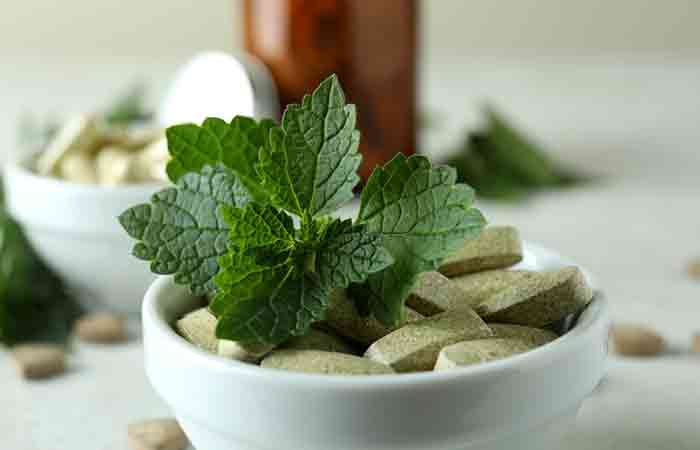
Nettle leaves are extremely flexible and can be brewed as an organic tea, taken as a supplement, and applied as a lotion.
You can purchase dried/freeze-dried fallen leaves, pills, tinctures, and creams. Painful nettle lotions are frequently used to reduce osteoarthritis symptoms.
Studies suggest that the following doses are most effective for certain conditions ( 24 ):
- Allergies: 600 mg of freeze-dried leaves per day
- Enlarged prostate gland: 360 mg of root extract per day
It is available in several shops. The dried out leaves and flowers can be steeped to make a natural tea, while its leaves, roots, and stems can be cooked and contributed to soups, smoothie mixes, and stews.
Agnes Plume, a blog owner, tried stinging nettle tea and shared her experience in a blog post: "I initially consumed nettle tea in a little cortija in the Alpujarras. It was a significant moment as I really felt the makeover of the water relocate right into a thick brew in my throat. Minutes later on I really felt a fullness percolate through me that drew me down, rooted. I was acutely aware my feet were on the ground and felt as if I had a company and safety barrier around me ( i )”.
Paled nettles can be a good enhancement to your salad. Try tossing a couple of nettle leaves into your salad. If that doesn't sound enticing, you can make a mug of fresh tea with nettle.
How To Make Stinging Nettle Tea

What You Need
- Fresh or dried nettle leaves – 1 loose cup (about 250ml)
- Water – 1-2 cups
- Boiling pot or kettle
Let’s Make It!
- Bring the water to a boil in a kettle or pot.
- Add the nettle leaves to the boiling water.
- Turn off the heat. Let it steep for about 5-10 minutes.
- Strain the contents into the cup(s).
- You can add honey or stevia to this tea. However, refrain from adding sugar or sweetener if possible.
- Serve hot or warm!
You might find it sampling bitter and woody originally. A few mugs or days down, you will come to enjoy its freshness.
Additionally, pale the nettle greens in saltwater and utilize them in salads or pesto. You can likewise sauté the eco-friendlies in oil, butter, or other food preparation fat. This can be appreciated with red or breast meat and contributed to salads.
Ingesting nettle greens is a popular and extra efficient way of getting their benefits. However they are wild plants and called 'stinging' nettles. Should you be concerned?
Absolutely! Check out the adverse effects of using nettle leaves.
What Are The Side Effects Of Stinging Nettle?
Well, unlike their wildness, nettles are taken into consideration secure. There are really couple of negative effects of having them, but none are lethal or poisonous ( 25 ).
Hair-like barbs of nettle leaves can harm the skin. These barbs can inject a variety of chemicals, such as ( 23 ):
- Acetylcholine
- Histamine
- Serotonin
- Moroidin
- Formic acid
These compounds can cause burning and rashes.
Scientists found that nettle origins may create GI system disturbances, excessive sweating, and allergic reactions in some individuals. Freshly tweezed nettle leaves could cause localized painful, rash, itching, and tongue edema ( 25 ).
But as they act as an emmenagogue, they might possess uterine-stimulant residential or commercial properties. If pregnant women take nettles without clinical supervision, they could enter into early labor.
Cooked and dried stinging nettle is safe to consume. However, eating fresh leaves may cause irritation.
Do You Know How The Nettle Stings?
- The irritable hairs of the nettle have a tiny tube-like framework. This has a hard-round light bulb at the suggestion and a softer vessel at the base.
- The bulb ruptures when it encounters skin and exposes a needle-like protrusion.
- When this tip pierces the skin, it puts pressure on the soft, basal vessel.
- This launches the irritating compounds (viz., acetylcholine and histamine) deep into the skin. This develops the red, angry, scratchy, and shedding patches on revealed sites.
Infographic: Easy Stinging Nettle Soup – Recipe
Stinging nettle is used because old times for the numerous benefits it supplies. This herb is understood for its healing residential or commercial properties. Besides tea, you can additionally prepare stinging nettle soup and enjoy its benefits.
Check out the infographic to learn the steps.
Illustration: StyleCraze Design Team
Get the high-quality PDF version of this infographic.


Share
The wellness advantages of painful nettle can be attributed to its abundant profile of potent anti-oxidants such as phenolic acids and flavonoids. These substances promote the wellness of the cardiovascular system, liver, and reproductive system. Stinging nettle leaves might help reduce swelling, boost digestion, advertise detoxification, boost iron absorption, increase injury recovery, and might help conciliate hay high temperature, allergies, and asthma. Additionally, they reinforce and promote hair development. You can reap the benefits of painful nettle by drinking its natural tea, using lotion, or taking its supplements. However, excess intake may bring about a couple of negative effects. Because the safety requirements have not been established, pregnant and nursing females must consult a physician prior to eating it.
Frequently Asked Questions
Does nettle tea help you sleep?
Yes. Nettle tea promotes better sleep without increasing blood sugar levels, which makes sleep deeper.
How much nettle tea should you drink a day?
The maximum recommended use of nettle tea is four cups per day.
Does nettle tea contain silica?
Yes, nettle leaves contain silica ( 26 ).
Is stinging nettle good for the kidneys?
Yes. The painful nettle can have healing impacts toward urinary system infections and kidney rocks. The flavonoids, anthocyanins, and saponins present in stinging nettle can help prevent calcium and oxalate deposition ( 27 ).
Does stinging nettle interact with medications?
Yes. Using herbal medications like nettle entrusts to anti-inflammatory medications is not suggested as they may engage with miracle drugs. Do not take these leaves when you get on painkillers or comparable medications without consulting your physician.
What is the difference between nettle and stinging nettle?
Both refer to the same plant. It is also referred to as burn nettle or the common nettle.
Does stinging nettle have caffeine?
No, stinging nettle does not have high levels of caffeine. It is rich in vitamin A, vitamin C, iron, calcium and salt while additionally being a good source of phenylpropanoids and caffeic acid ( 1 ).
Does stinging nettle boost the immune system?
Yes. Stinging nettle is rich in antioxidants like phenolic acids and flavonoids. These antioxidants can boost the immune system ( 28 ).
Key Takeaways
- As a herbal medicine, stinging nettle helps promote hair growth and strength.
- Consuming stinging nettle can help with conditions like hay fever, asthma, and other allergies.
- Being a natural diuretic, it helps regulate blood sugar levels.
- You can make nettle tea by boiling 1 cup of fresh or dried leaves in 1 to 2 cups of water.


